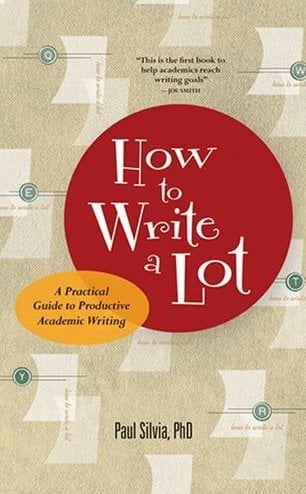
Paul Silvia
Paul J. Silvia teaches psychology at the University of North Carolina, Greensboro. In
How to Write a Lot: A Practical Guide to Productive Academic Writing, Silvia chiefly pleads with his readers to set aside specific, regular blocks of time for writing and to adhere steadfastly to this schedule ( 16–17). “The secret,” he says, “is the regularity, not the number of days or the number of hours [allotted for writing]” ( 13). Silvia argues that observing such a regular writing schedule will allow an author to produce better material more efficiently ( 1). “More efficiently” does not, of course, necessarily indicate that all academics should publish a large quantity of material; those whose interests lie elsewhere can still use a regular writing schedule to produce the quantity of literature that they wish. Thus, Silvia suggests that a more accurate title for the volume would be How to Write More Productively During the Normal Work Week with Less Anxiety and Guilt, but he humorously recognizes that such a title may well have inhibited book sales ( 130).
To motivate his readers to take his advice about writing schedules, Silvia addresses four common barriers to productive writing and regular writing times ( 11–27). First, Silvia addresses the difficulty of finding large blocks of time to write by asking his audience to consider writing to be part of the set of required tasks that academics have. “Do you need to ‘find time to teach’?” he queries, “Of course not—you have a teaching schedule, and you never miss it. . . . Instead of finding time to write, allot time to write” ( 12). Second, Silvia cautions against the literary paralysis that can result from a constant feeling of needing to read more about a topic before writing about it. Doing this reading during one’s scheduled writing time can eliminate the roadblock it presents to the writing process ( 18–19). Third, perceived workspace or equipment inadequacies cannot be allowed to be deterrents from writing ( 19–23). Fourth, waiting for inspiration or “feeling like writing,” at least for those who do not intend to produce novels or poetry, should not dissuade someone from a regular schedule because keeping that schedule will itself generally prompt more ideas for writing and more occasions when an author feels like writing ( 23–27).
After attempting to dispatch these common roadblocks to productive writing, Silvia suggests some “motivational tools,” including: setting reasonable goals to achieve within one’s regular writing times, prioritizing different projects appropriately, and monitoring one’s progress ( 30–45). He also comments at length on starting and running a writing accountability group ( 49–57).
Silvia briefly discusses some characteristics of good writing style ( 59–76) before giving specific counsel for writing journal articles ( 77–107) and books ( 109–25). For journal articles, Silvia provides numerous specific tips ( 78–98)—some of which specifically relate to his own field of psychology but may still apply to articles submitted in New Testament studies—and a general counsel: Assume that any article submitted will be rejected ( 98). Silvia intends this counsel to calm fears about “what if. . . ,” and he encourages his readers to think of article rejections as a “publication tax,” or a cost that must be payed to have other things published ( 100–101). For books, Silvia suggests finding a co-author if necessary ( 112–13), and he provides some tips for authors when they want to “sell” their books to publishers ( 118–23).
While Silvia’s book contains numerous, practical hints for various issues that arise during the writing process, the book has a unified message: “Make a writing schedule, keep it, and you will write more than you do.” The “plan and persist” mantra is, perhaps, somewhat oversimplified at times, but this simplicity too serves Silvia’s purpose. How to Write a Lot: A Practical Guide to Productive Academic Writing, in the end, does “guide,” but this guidance is designed also to motivate.
Looking at beginning the dissertation phase here at Southeastern later this year, I found Silvia’s book encouraging, but perhaps more encouraging is a very simple writing schedule. If someone were only to average one page each week day, that person would write about 261 pages each year. At about 350 words per page, our hypothetical student would write in one year 91,350 words on a project where something around 100,000 words seems to be a fairly standard finishing length. Others who have already walked this road will certainly have a more nuanced perspective, but at the beginning of the road at least, such things are encouraging.